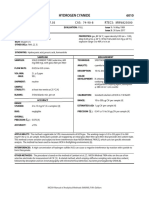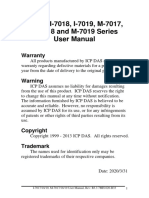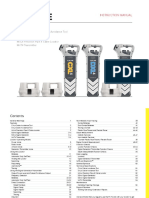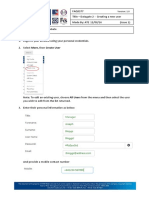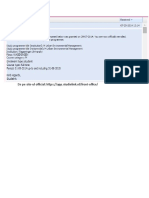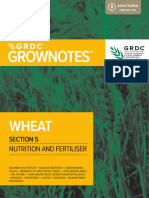Instruction Manual Single Method - M100 - Chlorine T - en PDF
Instruction Manual Single Method - M100 - Chlorine T - en PDF
Uploaded by
GabiBaciuCopyright:
Available Formats
Instruction Manual Single Method - M100 - Chlorine T - en PDF
Instruction Manual Single Method - M100 - Chlorine T - en PDF
Uploaded by
GabiBaciuOriginal Title
Copyright
Available Formats
Share this document
Did you find this document useful?
Is this content inappropriate?
Copyright:
Available Formats
Instruction Manual Single Method - M100 - Chlorine T - en PDF
Instruction Manual Single Method - M100 - Chlorine T - en PDF
Uploaded by
GabiBaciuCopyright:
Available Formats
Chlorine T / M100
Chlorine T M100
0.01 - 6.0 mg/l Cl2 a) CL6
DPD
Instrument specific information
The test can be performed on the following devices. In addition, the required cuvette and
the absorption range of the photometer are indicated.
Instrument Type Cuvette λ Measuring Range
MD 100, MD 110, MD 200, ø 24 mm 530 nm 0.01 - 6.0 mg/l Cl2 a)
MD 600, MD 610, MD 640,
MultiDirect, PM 600, PM 620,
PM 630
Scuba II ø 24 mm 530 nm 0.1 - 6.0 mg/l Cl2 a)
XD 7000, XD 7500 ø 24 mm 510 nm 0.01 - 6.0 mg/l Cl2 a)
SpectroDirect ø 24 mm 510 nm 0.02 - 6.0 mg/l Cl2 a)
Material
Required material (partly optional):
Reagents Packaging Unit Part Number
DPD No. 1 Tablet / 100 511050BT
DPD No. 1 Tablet / 250 511051BT
DPD No. 1 Tablet / 500 511052BT
DPD No. 3 Tablet / 100 511080BT
DPD No. 3 Tablet / 250 511081BT
DPD No. 3 Tablet / 500 511082BT
DPD No. 1 High Calcium e) Tablet / 100 515740BT
DPD No. 1 High Calcium e)
Tablet / 250 515741BT
DPD No. 1 High Calcium e) Tablet / 500 515742BT
DPD No. 3 High Calcium e)
Tablet / 100 515730BT
DPD No. 3 High Calcium e) Tablet / 250 515731BT
DPD No. 3 High Calcium e)
Tablet / 500 515732BT
DPD No. 4 Tablet / 100 511220BT
DPD No. 4 Tablet / 250 511221BT
DPD No. 4 Tablet / 500 511222BT
Refill Pack Scuba II 1 pc. 525600
2 EN Method Reference Book 1.0
Chlorine T / M100
Available Standards
Title Packaging Unit Part Number
ValidCheck Chlorine 1,5 mg/l 98.5 + 1.5 ml 48105510
Application List
• Waste Water Treatment
• Disinfection Control
• Boiler Water
• Cooling Water
• Raw Water Treatment
• Pool Water Control
• Pool Water Treatment
• Drinking Water Treatment
Sampling
1. When preparing the sample, Chlorine outgassing, e.g. through the pipette or shak-
ing, must be avoided.
2. The analysis must take place immediately after taking the sample.
Preperation
1. Cleaning of vials:
As many household cleaners (e.g. dishwasher detergent) contain reducing sub-
stances, this can lead to lower results with the determination of Chlorine. To avoid
measurement errors, the glassware used should be free of chlorine consumption. To
achieve this, all glassware should be placed in a sodium hypochlorite solution (0.1 g/
l) for one hour and then rinsed thoroughly with deionised water.
2. For individual testing of free and total Chlorine, the use of different sets of glassware
is recommended (EN ISO 7393-2, 5.3)
3. The DPD colour development is carried out at a pH value of 6.2 to 6.5. The reagents
therefore contain a buffer for the pH adjustment. Strong alkaline or acidic water sam-
ples must therefore be adjusted between pH 6 and pH 7 before the analysis (use 0.5
mol/l Sulphuric acid or 1 mol/l Sodium hydroxide).
EN Method Reference Book 1.0 3
Chlorine T / M100
Implementation of the provision free chlorine with tablet
Select the method on the device
In addition, choose the test: free
For this method, no ZERO measurements are to be carried out with the following de-
vices: XD 7000, XD 7500
10 ml
Sample
Fill 24 mm vial with 10 ml Close vial(s). Place sample vial in the
sample. sample chamber. • Pay at-
tention to the positioning.
Zero
Press the ZERO button. Remove the vial from the Empty vial except for a few
sample chamber. drops.
For devices that require no ZERO measurement , start here.
24 mm
Add DPD No. 1 tablet . Crush tablet(s) by rotating Fill up vial with sample to
slightly. the 10 ml mark.
4 EN Method Reference Book 1.0
Chlorine T / M100
Sample
Close vial(s). Dissolve tablet(s) by invert- Place sample vial in the
ing. sample chamber. • Pay at-
tention to the positioning.
Test
Press the TEST (XD:
START)button.
The result in mg/l free chlorine appears on the display.
EN Method Reference Book 1.0 5
Chlorine T / M100
Implementation of the provision total Chlorine with tablet
Select the method on the device
In addition, choose the test: total
For this method, no ZERO measurements are to be carried out with the following de-
vices: XD 7000, XD 7500
10 ml
Sample
Fill 24 mm vial with 10 ml Close vial(s). Place sample vial in the
sample. sample chamber. • Pay at-
tention to the positioning.
Zero
Press the ZERO button. Remove the vial from the Empty vial except for a few
sample chamber. drops.
For devices that require no ZERO measurement , start here.
24 mm
Add DPD No. 1 tablet . Add DPD No. 3 tablet . Crush tablet(s) by rotating
slightly.
6 EN Method Reference Book 1.0
Chlorine T / M100
Fill up vial with sample to Close vial(s). Dissolve tablet(s) by invert-
the 10 ml mark. ing.
2 min
Test 10
11
12
1
2
9 3
8 4
7 5
6
Sample
Place sample vial in the Press the TEST (XD: Wait for 2 minute(s) reac-
sample chamber. • Pay at- START)button. tion time.
tention to the positioning.
Once the reaction period is finished, the measurement takes place automatically.
The result in mg/l total Chlorine appears on the display.
EN Method Reference Book 1.0 7
Chlorine T / M100
Implementation of the provision Chlorine differentiated with
tablet
Select the method on the device
In addition, choose the test: differentiated
For this method, no ZERO measurements are to be carried out with the following de-
vices: XD 7000, XD 7500
10 ml
Sample
Fill 24 mm vial with 10 ml Close vial(s). Place sample vial in the
sample. sample chamber. • Pay at-
tention to the positioning.
Zero
Press the ZERO button. Remove the vial from the Empty vial except for a few
sample chamber. drops.
For devices that require no ZERO measurement , start here.
24 mm
Add DPD No. 1 tablet . Crush tablet(s) by rotating Fill up vial with sample to
slightly. the 10 ml mark.
8 EN Method Reference Book 1.0
Chlorine T / M100
Sample
Close vial(s). Dissolve tablet(s) by invert- Place sample vial in the
ing. sample chamber. • Pay at-
tention to the positioning.
Test
Press the TEST (XD: Remove the vial from the Add DPD No. 3 tablet .
START)button. sample chamber.
24 mm
Crush tablet(s) by rotating Close vial(s). Dissolve tablet(s) by invert-
slightly. ing.
EN Method Reference Book 1.0 9
Chlorine T / M100
2 min
Test 10
11
12
1
2
9 3
8 4
7 5
6
Sample
Place sample vial in the Press the TEST (XD: Wait for 2 minute(s) reac-
sample chamber. • Pay at- START)button. tion time.
tention to the positioning.
Once the reaction period is finished, the measurement takes place automatically.
The result in mg/l free chlorine, mg/l combined chlorine, mg/l total chlorine appears on
the display.
10 EN Method Reference Book 1.0
Chlorine T / M100
Chemical Method
DPD
Appendix
Calibration function for 3rd-party photometers
Conc. = a + b∙Abs + c∙Abs2 + d∙Abs3 + e∙Abs4 + f∙Abs5
ø 24 mm □ 10 mm
a -5.41232 ∙ 10-2 -5.41232 ∙ 10-2
b 1.78498 ∙ 10 +0
3.83771 ∙ 10+0
c -8.7417 ∙ 10-2 -4.04085 ∙ 10-1
d 1.08323 ∙ 10 -1
1.07655 ∙ 10+0
e
f
Interferences
Persistant Interferences
• All oxidising agents in the samples react like chlorine, which leads to higher results.
Removeable Interferences
• Interference from Copper and Iron (III) are eliminated by the addition of EDTA.
• The use of reagent tablets in samples with high Calcium content* and/or high con-
ductivity* can lead to turbidity of the sample and therefore incorrect measurements.
In this case, the alternative reagent tablet DPD No. 1 High Calcium and reagent
tablet DPD No. 3 High Calcium should be used.
*it is not possible to give exact values, because the development of turbidity depends
on the composition and nature of the sample.
• Concentrations above 10 mg/l Chlorine, in the event of using fluid reagents, can lead
to results within the measuring range of up to 0 mg/l. In the event of a high concen-
tration of Chlorine, the sample must be diluted with chlorine-free water. 10 ml of the
diluted sample should be mixed with the reagent and the measurement taken again
(plausibility test).
Interference from / [mg/l]
CrO4 2-
0.01
MnO2 0.01
EN Method Reference Book 1.0 11
Chlorine T / M100
Method Validation
Limit of Detection 0.02 mg/l
Limit of Quantification 0.06 mg/l
End of Measuring Range 6 mg/l
Sensitivity 2.05 mg/l / Abs
Confidence Intervall 0.04 mg/l
Standard Deviation 0.019 mg/l
Variation Coefficient 0.87 %
Conformity
EN ISO 7393-2
determination of free, combined and total | e) alternative reagent, used instead of DPD No.1/No.3 in case of turbidity
a)
in the water sample caused by high concentration of calcium and/or high conductivity
12 EN Method Reference Book 1.0
You might also like
- Bathymetric Profile and Water Quality Assessment of Queen Tuna ParkDocument48 pagesBathymetric Profile and Water Quality Assessment of Queen Tuna ParkEzer Sara'elNo ratings yet
- Conquering Chemistry Module 2Document88 pagesConquering Chemistry Module 2Shayan Lahijanian0% (1)
- Chlorine, Free: DPD Method Method 10102 0.09 To 5.00 MG/L CL Test 'N Tube VialsDocument6 pagesChlorine, Free: DPD Method Method 10102 0.09 To 5.00 MG/L CL Test 'N Tube VialsOudah AliNo ratings yet
- DOC3165301028 11edDocument6 pagesDOC3165301028 11edKushal SharmaNo ratings yet
- ChlorineTotalDPDTNT DOC316.53.01028Document6 pagesChlorineTotalDPDTNT DOC316.53.01028Khải Trương ĐìnhNo ratings yet
- DOC3165301304 5edDocument6 pagesDOC3165301304 5edKushal SharmaNo ratings yet
- Chlorine HR PP M111 0.1 - 8 MG/L CL CL8 DPD: Instrument Specific InformationDocument10 pagesChlorine HR PP M111 0.1 - 8 MG/L CL CL8 DPD: Instrument Specific Informationcristi5cNo ratings yet
- Chlorine Dioxide: DPD Method Method 10126 0.04 To 5.00 MG/L Clo Powder PillowsDocument6 pagesChlorine Dioxide: DPD Method Method 10126 0.04 To 5.00 MG/L Clo Powder Pillowshiba JamalNo ratings yet
- Fluoride 0,05-2 MG 467481Document5 pagesFluoride 0,05-2 MG 467481Perdana MaharaniNo ratings yet
- Chlorine, Total: Usepa DPD Method Method 10070 0.1 To 10.0 MG/L CL (HR) Powder PillowsDocument6 pagesChlorine, Total: Usepa DPD Method Method 10070 0.1 To 10.0 MG/L CL (HR) Powder PillowsOscar MachadoNo ratings yet
- Doc316 53 01304 PDFDocument6 pagesDoc316 53 01304 PDFYessenia GonzalesNo ratings yet
- Chlorine, Free: Usepa DPD Method Method 10245 0.05 To 4.00 MG/L CL (MR) Powder PillowsDocument6 pagesChlorine, Free: Usepa DPD Method Method 10245 0.05 To 4.00 MG/L CL (MR) Powder PillowsPedro MamaniNo ratings yet
- Chlorine, Total, MR: Usepa DPD Method Method 10250 0.05 To 4.00 MG/L CL (MR) Powder PillowsDocument6 pagesChlorine, Total, MR: Usepa DPD Method Method 10250 0.05 To 4.00 MG/L CL (MR) Powder PillowswoodywheelNo ratings yet
- Organic Carbon Total HR TNT 10128Document8 pagesOrganic Carbon Total HR TNT 10128okgnosasNo ratings yet
- DOC316.53.01153 8ed PDFDocument6 pagesDOC316.53.01153 8ed PDFHugo Armando Iral MaldonadoNo ratings yet
- Sulfite: Iodate-Iodide Method Method 8071 0-500 MG/L As SO (Or 0 To More Than 500 MG/L) Buret TitrationDocument6 pagesSulfite: Iodate-Iodide Method Method 8071 0-500 MG/L As SO (Or 0 To More Than 500 MG/L) Buret Titrationahmad sutejaNo ratings yet
- Chlorine, Free: Usepa DPD Method Method 10245 0.05 To 4.00 MG/L CL (MR) Powder PillowsDocument6 pagesChlorine, Free: Usepa DPD Method Method 10245 0.05 To 4.00 MG/L CL (MR) Powder PillowsClydeA.Sardoncillo100% (1)
- Silica: Heteropoly Blue Method Method 8282 3 To 1000 Μg/L Sio Reagent SolutionDocument6 pagesSilica: Heteropoly Blue Method Method 8282 3 To 1000 Μg/L Sio Reagent SolutionShesharam ChouhanNo ratings yet
- ChlorineTotalDPD DOC316.53.01029Document6 pagesChlorineTotalDPD DOC316.53.01029Khải Trương ĐìnhNo ratings yet
- Chlorine Dioxide: Direct Reading Method Method 8345 1 To 50 MG/L Clo (MR)Document4 pagesChlorine Dioxide: Direct Reading Method Method 8345 1 To 50 MG/L Clo (MR)Dody PurmadaniNo ratings yet
- Chloride: Silver Nitrate Method Method 8207 10 To 10,000 MG/L As CL Digital TitratorDocument6 pagesChloride: Silver Nitrate Method Method 8207 10 To 10,000 MG/L As CL Digital TitratorAlbertoNo ratings yet
- AP 034 900.chlorine Free DPDDocument4 pagesAP 034 900.chlorine Free DPDjcortezcNo ratings yet
- OrganicCarbonTotalDirectTNT DOC316.53.01093Document8 pagesOrganicCarbonTotalDirectTNT DOC316.53.01093yocam2No ratings yet
- Dureza 2Document6 pagesDureza 2proentecsasNo ratings yet
- Chlorine Free DPDDocument8 pagesChlorine Free DPDEndang SupriyatnaNo ratings yet
- HIERRO TNT PlusDocument4 pagesHIERRO TNT PlusYURY ORTEGANo ratings yet
- Doc316 53 01532Document4 pagesDoc316 53 01532Praful N KNo ratings yet
- Hardness: DR 900 Analytical ProcedureDocument4 pagesHardness: DR 900 Analytical Procedurewulalan wulan100% (1)
- HACH Chloride by Thiocyanate-Method No.8113-DOC316.53.01017 - Ed7Document6 pagesHACH Chloride by Thiocyanate-Method No.8113-DOC316.53.01017 - Ed7Balas43No ratings yet
- Chlorine Dioxide, Method 10126, 02-2009, 9th EdDocument8 pagesChlorine Dioxide, Method 10126, 02-2009, 9th EdRajeshkumar ElangoNo ratings yet
- Hach Low Range TestDocument8 pagesHach Low Range TestEka 'kasboen' ArsanatravissinatraFramdiasNo ratings yet
- ChlorineFreeDPD DOC316.53.01025Document6 pagesChlorineFreeDPD DOC316.53.01025Khải Trương ĐìnhNo ratings yet
- Hach AlcalinidadDocument4 pagesHach AlcalinidadOmar Campuzano CalderónNo ratings yet
- LaMotte 3622 Chlorine Dioxide Kit InstructionsDocument3 pagesLaMotte 3622 Chlorine Dioxide Kit InstructionsPromagEnviro.comNo ratings yet
- Total Chlorine Procedures Oct - 05Document27 pagesTotal Chlorine Procedures Oct - 05augustine amaraNo ratings yet
- Chloramine (Mono) : Indophenol Method Method 10172 0.1 To 10.0 MG/L CL (HR) Test 'N TubeDocument6 pagesChloramine (Mono) : Indophenol Method Method 10172 0.1 To 10.0 MG/L CL (HR) Test 'N Tubephandang_tNo ratings yet
- Chloride 8113Document6 pagesChloride 8113okgnosasNo ratings yet
- Doc316 53 01061Document6 pagesDoc316 53 01061Naranyu JantarawongsaNo ratings yet
- LaMotte 3670-01 DC1200-CL Chlorine Colorimeter Tablet DPD Kit InstructionsDocument4 pagesLaMotte 3670-01 DC1200-CL Chlorine Colorimeter Tablet DPD Kit InstructionsPromagEnviro.comNo ratings yet
- Método PrataDocument6 pagesMétodo PrataCorinne MartinNo ratings yet
- Metodo Determinacion de Cadmio Hach DR 3900Document6 pagesMetodo Determinacion de Cadmio Hach DR 3900Buenaventura Jose Huamani TalaveranoNo ratings yet
- Volatile Acids: Sodium Hydroxide Method Method 8291 100-2400 MG/L CH COOH (Acetic Acid) Buret TitrationDocument4 pagesVolatile Acids: Sodium Hydroxide Method Method 8291 100-2400 MG/L CH COOH (Acetic Acid) Buret TitrationtAYTAYNo ratings yet
- ChlorineFreeDPD DOC316.53.01303Document6 pagesChlorineFreeDPD DOC316.53.01303Khải Trương ĐìnhNo ratings yet
- Copper Low Range DOC316.53.01038Document6 pagesCopper Low Range DOC316.53.01038krishna karuturiNo ratings yet
- DOC316.52.93097 - 5ed - Chlorine Dioxide Chlorite in WaterDocument15 pagesDOC316.52.93097 - 5ed - Chlorine Dioxide Chlorite in Waterhiba JamalNo ratings yet
- DOC3165301031Document10 pagesDOC3165301031Kushal SharmaNo ratings yet
- Potassium: Tetraphenylborate Method Method 8049 0.1 To 7.0 MG/L K Powder PillowsDocument8 pagesPotassium: Tetraphenylborate Method Method 8049 0.1 To 7.0 MG/L K Powder Pillowsjenniffer maltesNo ratings yet
- Chlorine, Free, Low Range: Usepa DPD Method Method 8021 0.02 To 2.0 MG/L CL Swiftest DispenserDocument6 pagesChlorine, Free, Low Range: Usepa DPD Method Method 8021 0.02 To 2.0 MG/L CL Swiftest Dispenserjosé gaspar gasparNo ratings yet
- LaMotte 3671-01 DC1200-CLO Chlorine Dioxide Colorimeter Kit InstructionsDocument4 pagesLaMotte 3671-01 DC1200-CLO Chlorine Dioxide Colorimeter Kit InstructionsPromagEnviro.comNo ratings yet
- Doc316 53 01101Document10 pagesDoc316 53 01101Iman Kurnia ShiddiqNo ratings yet
- Silica LRDocument6 pagesSilica LRcolorNo ratings yet
- Uop 481 - 10Document13 pagesUop 481 - 10lovehackinggalsNo ratings yet
- Doc316 53 01132Document6 pagesDoc316 53 01132Jojit Y CortesNo ratings yet
- Hydrogen Cyanide 6010: HCN MW: 27.03 CAS: 74-90-8 RTECS: MW6825000Document5 pagesHydrogen Cyanide 6010: HCN MW: 27.03 CAS: 74-90-8 RTECS: MW6825000Ngọc Ánh LêNo ratings yet
- Doc3165301487 OjoDocument6 pagesDoc3165301487 OjoLilia Rosa Ibáñez SierrauyNo ratings yet
- Sulfatos PDFDocument6 pagesSulfatos PDFOscar MachadoNo ratings yet
- CopperPorphyrin DOC316.53.01038Document6 pagesCopperPorphyrin DOC316.53.01038Edan ManzanNo ratings yet
- DOC3165301449 7edDocument8 pagesDOC3165301449 7edLilia Rosa Ibáñez SierrauyNo ratings yet
- 6010 PDFDocument5 pages6010 PDFJoshua PerryNo ratings yet
- Practical Manual of Analytical ChemistryFrom EverandPractical Manual of Analytical ChemistryRating: 4.5 out of 5 stars4.5/5 (3)
- Standard methods for the examination of water and sewageFrom EverandStandard methods for the examination of water and sewageNo ratings yet
- MAN-2004-0001-C - User Guide - Pcorr and Permalog Using WebCorr App PDFDocument56 pagesMAN-2004-0001-C - User Guide - Pcorr and Permalog Using WebCorr App PDFGabiBaciuNo ratings yet
- MAN-146-0001-B (Multilog LX 2 - Installation User Guide) PDFDocument56 pagesMAN-146-0001-B (Multilog LX 2 - Installation User Guide) PDFGabiBaciu100% (1)
- Data Loggers Selection Guide V3 June 2020Document1 pageData Loggers Selection Guide V3 June 2020GabiBaciuNo ratings yet
- M-7000 Address Mapping (Base 1)Document54 pagesM-7000 Address Mapping (Base 1)GabiBaciuNo ratings yet
- GB 3.1 Flow Converter 713 Manual 0704Document20 pagesGB 3.1 Flow Converter 713 Manual 0704CharbsNo ratings yet
- Manual KAPTOR - EN - VS 1.0 Rev 20-07-16 PDFDocument176 pagesManual KAPTOR - EN - VS 1.0 Rev 20-07-16 PDFGabiBaciuNo ratings yet
- M 7084 User Manual PDFDocument131 pagesM 7084 User Manual PDFGabiBaciuNo ratings yet
- I-7017, I-7018, I-7019, M-7017, M-7018 and M-7019 Series User ManualDocument225 pagesI-7017, I-7018, I-7019, M-7017, M-7018 and M-7019 Series User ManualGabiBaciuNo ratings yet
- 17 Instruction-Manual 4-Range PDFDocument68 pages17 Instruction-Manual 4-Range PDFGabiBaciuNo ratings yet
- Irf 530 NPBFDocument9 pagesIrf 530 NPBFGabiBaciuNo ratings yet
- Datagate New User Setup PDFDocument5 pagesDatagate New User Setup PDFGabiBaciuNo ratings yet
- 620 300 600 700 Tama Zoo 600 Science Museum, Tokyo 720 620 300Document8 pages620 300 600 700 Tama Zoo 600 Science Museum, Tokyo 720 620 300GabiBaciuNo ratings yet
- Nmame: Profesional Statement RRRRRRRRR RR R R My SPDDDD My SPDDDDDocument1 pageNmame: Profesional Statement RRRRRRRRR RR R R My SPDDDD My SPDDDDGabiBaciuNo ratings yet
- Utiliare DatagateDocument1 pageUtiliare DatagateGabiBaciuNo ratings yet
- LondraDocument5 pagesLondraGabiBaciuNo ratings yet
- Proof of Enrolment 2014-2015Document1 pageProof of Enrolment 2014-2015GabiBaciuNo ratings yet
- GES-RO - Design Engineer (Eng-E3) - EN + BatchDocument4 pagesGES-RO - Design Engineer (Eng-E3) - EN + BatchGabiBaciuNo ratings yet
- DF F DF FD DF GD FSD FSD FSD Fs Das FDFDocument9 pagesDF F DF FD DF GD FSD FSD FSD Fs Das FDFGabiBaciuNo ratings yet
- DF F Dffegdfgb FSD Fs Das D D D D DDDDDDDDDDDDDocument14 pagesDF F Dffegdfgb FSD Fs Das D D D D DDDDDDDDDDDDGabiBaciuNo ratings yet
- Smarand ADocument2 pagesSmarand AGabiBaciuNo ratings yet
- International Baccalaureate: Chemistry HL Internal Assessment May 2020Document17 pagesInternational Baccalaureate: Chemistry HL Internal Assessment May 2020login ackyipNo ratings yet
- Enhance Your Measuring Precision: Umix Magnetic StirrerDocument2 pagesEnhance Your Measuring Precision: Umix Magnetic StirrerAdam MazurekNo ratings yet
- Analysis of Fluoride Content in Alternative Milk BeveragesDocument5 pagesAnalysis of Fluoride Content in Alternative Milk BeveragesPreeyanikaa LogonathanNo ratings yet
- A2 Level Chemistry Assessed HomeworkDocument6 pagesA2 Level Chemistry Assessed Homeworkafmsuaddt100% (1)
- Buffers and Titrations Student PDFDocument20 pagesBuffers and Titrations Student PDFPawan BabelNo ratings yet
- Application of Ionic Equiibria Process Simulation For Atmospheric Distillation Overhead SystemsDocument15 pagesApplication of Ionic Equiibria Process Simulation For Atmospheric Distillation Overhead SystemsGraham 'Bruce' LavenderNo ratings yet
- Manuscript Details: Submission Files Included in This PDFDocument36 pagesManuscript Details: Submission Files Included in This PDFnawabNo ratings yet
- Identification and Evaluation of Herbal Based Cough Syrup, Lipstick and Cold Cream by Using Lepidium SativumDocument19 pagesIdentification and Evaluation of Herbal Based Cough Syrup, Lipstick and Cold Cream by Using Lepidium SativumMr.S. p.royNo ratings yet
- Stability - Study - of - The - Pigment - Extract - From - A - Wild - SangineusDocument8 pagesStability - Study - of - The - Pigment - Extract - From - A - Wild - SangineusEmilyNo ratings yet
- Answer Module 7A Acid and BasesDocument5 pagesAnswer Module 7A Acid and BasesYen ZyNo ratings yet
- The Amount of Acetic Acid (ML) To Neutralise Sodium-Bicarbonate Ethanoic-Acid Solution at Different Concentrations (Molar) of Acetic AcidDocument8 pagesThe Amount of Acetic Acid (ML) To Neutralise Sodium-Bicarbonate Ethanoic-Acid Solution at Different Concentrations (Molar) of Acetic AcideoqcwxhfhsedwcddmyNo ratings yet
- Apch14 Practest AnsDocument3 pagesApch14 Practest AnsOlivia GrovesNo ratings yet
- Homeworks 1 eDocument8 pagesHomeworks 1 eSumi VjNo ratings yet
- 1 s2.0 S246822762030346X MainDocument10 pages1 s2.0 S246822762030346X Mainaulia nova kusumaningtyasNo ratings yet
- KHAMANGA-Pharmaceutics 3 - Stability 2021-AUGUST 2021Document83 pagesKHAMANGA-Pharmaceutics 3 - Stability 2021-AUGUST 2021AkshayKumarSinghNo ratings yet
- Chap 19Document4 pagesChap 19Jimini KimNo ratings yet
- Tina Chemistry ResearchDocument4 pagesTina Chemistry ResearchYuri CeladaNo ratings yet
- 1.7 Batch Cell Culture 2Document36 pages1.7 Batch Cell Culture 2Astra BeckettNo ratings yet
- Meat PH Tester: Refilling The ElectrodeDocument2 pagesMeat PH Tester: Refilling The ElectrodeFranco YnquillaNo ratings yet
- Cala. AcidsDocument8 pagesCala. AcidsdeeboloyantNo ratings yet
- CHEM1090 Week 12 PASS Worksheet+AnswersDocument10 pagesCHEM1090 Week 12 PASS Worksheet+Answersmlhy2680No ratings yet
- 913 Conductivity Meter MetrohmDocument68 pages913 Conductivity Meter MetrohmMichael NgwenyaNo ratings yet
- Eutech 1700 Series Bench Meter BrochureDocument16 pagesEutech 1700 Series Bench Meter BrochureNur Hamizah YusoffNo ratings yet
- Formulation Success For Soy Beverages: Industry InnovationDocument1 pageFormulation Success For Soy Beverages: Industry InnovationPublicaNo ratings yet
- ThermodynamicsDocument73 pagesThermodynamicsВасиль КосівецьNo ratings yet
- Mud FactsDocument91 pagesMud FactsShamia EssamNo ratings yet
- Termamyl 120L Type L B-0552Document4 pagesTermamyl 120L Type L B-0552Antonio Deharo Bailon50% (2)
- GrowNote Wheat South 05 NutritionDocument40 pagesGrowNote Wheat South 05 NutritionYvonneNo ratings yet





















































